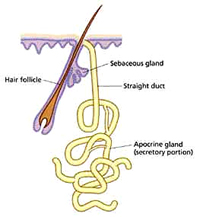 Cell
secretion involves the study of glands as well as the study of the cytoplasmic structures involved in producing and directing the
outflow of the material to be secreted. Cell
secretion involves the study of glands as well as the study of the cytoplasmic structures involved in producing and directing the
outflow of the material to be secreted.
Both aspects are included in
this lab. We will first examine the morphology of glands and then secretory differences based on staining and on modes of cellular
secretion. This will lead in to the study of membranes and
membranous organelles involved in cellular secretion and other
aspects of cellular metabolism.
Here's what you need to get from this
lab.
- Understand that glands are
composed mostly of epithelial cell aggregates clustered together
to perform specific secretory and/or excretory functions and
that there are two main types of glands: exocrine and endocrine.
- Distinguish the basic
differences between the parenchyma and stroma of a gland.
- Understand that exocrine
glands can be classified according to four features: the
secretory portion’s shape (alveolar vs. tubular), the duct
system (simple vs. compound), the nature of the secretion
(serous vs. mucous), and the mode of cell secretion (merocrine,
apocrine, or holocrine).
- Understand how the cell
membrane is “connected” to a system of membranous organelles in
the cytoplasm and how synthesis of material in the cell relates
to the various modes of cell secretion.
So, where do
these glands come from and what makes them up? |